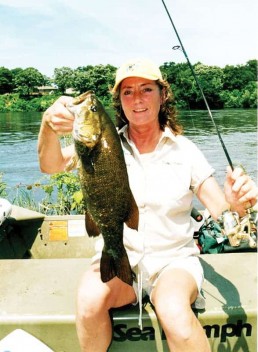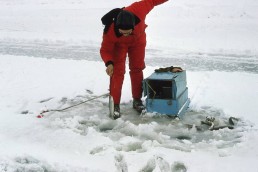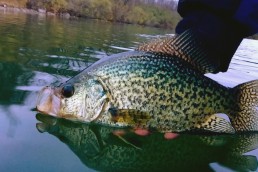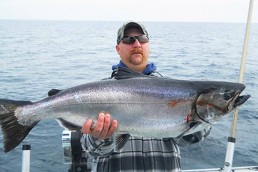What’s Old is New: Dabbling Still Produces Fish
SHARE THIS POST
Memories of an ancient snuff-chewing Alabaman named Ben Snurd float back to me when the “dabbling” technique is mentioned.
Old Ben had approached me in early March.
“Gapen, I know you have good crappie fishing on the lakes within the Army post at Fort Benning, but I’d sure like to show you some very large specks (local name given to crappie) that exist in the black swamp below the big dam,” Snurd said.
Ben was a neighbor who lived down the street from my wife, Beverly, and I when I was stationed on the post during part of the Korean War. He claimed to have a sure-fire method for taking crappies when they become leery.
Something new—how could I resist?
Our adventure began in fog and in a heavy swamp. We were in a battered, rusty, old jon boat. I immediately noticed two pair of cane poles. One was rigged with line, a sinker and an Upperman white jig. (Upperman supplied fishing kits for all the planes headed over the Atlantic during WWII. He found that a downed pilot could catch fish better with a jig, ranging from 1/8 to 3/8 ounce.) As we paddled deeper into the eerie swamp, I noticed that a forest fire or something else had destroyed a number of the huge cypress trees. Several had completely burned all the way down to within 2 feet of the water’s surface.
“Dan, these burned off stumps are the ones we want,” Ben said, as he slowed the boat each time a stump passed. “Near them, you’ll find panfish, especially crappies.”
Then with a “this-is-the-one” move, my educator tied the boat up to a tree 8 feet away from an ugly cinder stump. Grabbing one of the short cane poles, he began to beat the stump repeatedly. The trunk of the dead tree lay 20 feet, facing away from us.
“Kid, take one those rigged canes and drop the Upperman directly into the stump opening,” Ben instructed.
Just as the jig reached the area guessed to be the bottom, it was struck.
Out came a 2-pound speck. With line on the poles cut 2 feet shorter than the poles, the crappie slammed into me as I lifted it out of the hole in the stump.
Ben repeated my action, and another 2-pounder soon flopped on boat’s bottom.
“Gapen, how’s that for calling it?” my mentor commented.
We both then repeated the process and two more above-average crappies hit our boat’s floorboards.
In all, we took seven crappies out of that stump hole.
Are you enjoying this post?
You can be among the first to get the latest info on where to go, what to use and how to use it!
Next, we began to dabble our white jigs around the stump’s main structure. Four more, not quite as big, were caught before our presentations failed.
“Ben, that’s the damnedest thing I’ve ever seen,” I commented, as my guide decided to look for another target.
“Yup, partner. By beating the stump, I called them back when they’re frightened. Ya see, the stump is their home and once the beating signals ‘danger’ they run for home. Then, all we need to do is dabble inside for the big ones and around home for the smaller ones.”
This was my introduction to the dabbling technique, and not the last time I’d use it. Years later while fishing the Upper Mississippi, I found that running my boat up to shore in a bank eddy allowed me to dabble the smallmouths staging in there. Once the boat is tied off, or the boat’s bow is set up onshore, you allow up to five minutes for the environment to settle and then “dabble” close to either boat gunnels or directly under the outboard motor.
How does this work?
What you’ve done is to set up a homing structure in the eddy, allowing the disturbed bass to come back to and stage under your watercraft. Your boat becomes just another piece of structure—one to hide under. Remember, the river fish are used to debris like logs coming downstream and settling in positions to create new structure. River fish take advantage of these objects, which also carry food, such as hellgrammites, fly larvae and schools of minnows hiding around the floating structure.
Once things settle in the eddy, you can use a short 5-foot light-spinning rod loaded with a jig such as an Ugly Bug in the Crawfish color dropped directly alongside the boat. Anglers, you’d be amazed how many bass you can take out of an eddy by dabbling.
One trip down the Mississippi near home I was honored by the presence of Bill Binkelman, author of Lunkers Love Nightcrawlers and creator of Fishing Facts magazine.
Bill used 9-foot rods and dozens upon dozens of ‘crawlers. By the end of the day, he was using just the top of his rod and 1 inch of a ‘crawler. I had subjected Bill to dabbling in dead cottonwood trees in the river, ones that were lodged on shallow rock bars. One tree had numerous holes beneath it cut by the forces of the current. Bass food had gathered in these holes. We tied off at this location to dabble, using my old fishing partner’s theory.
“Gapen, I’d have never believed that you could catch 1- to 4-pound smallies 4 feet under the boat,” Bill commented, as he tussled a 4-pounder to the net. “And using only an inch of worm on your jig.”
Readers: Try dabbling. It’s easy and can produce dozens of fish with little effort. Dozens you probably would have passed by.
Remember, a short 5-foot spinning rod and a Gapen 1/16-ounce Ugly Bug are needed to dabble under your eddy-holding watercraft. It’s amazing how well this technique works on all fish species such as panfish, walleyes, bass and catfish. Old Ben is gone now, but if you see a dead stump with a hole in it, hit it a few times and try his technique—I’m sure he’ll be watching and get a kick out of your effort.
Considered one of the world’s leading river anglers, Dan Gapen, Sr. will continue to recount his past and recent adventures and offer up his knowledge to MidWest Outdoors readers.
MWO
SHARE THIS POST
Did you enjoy this post?
You can be among the first to get the latest info on where to go, what to use and how to use it!
Dan Gapen
Considered one of the world’s leading river anglers, Dan Gapen, Sr. has shared his knowledge with MidWest Outdoors readers and viewers for more than 40 years. He is a member of all three Fishing Halls of Fame—International, National Freshwater, and Minnesota. He has an immense grasp of the world’s fisheries. He may be contacted at 877-623-2099.
@TheGapenCompany.




